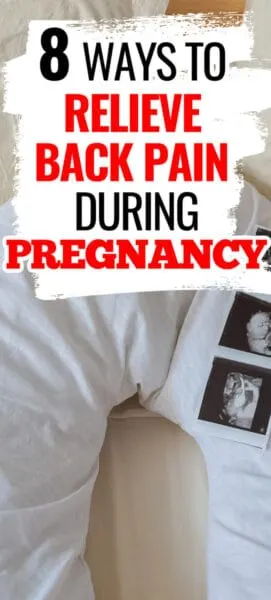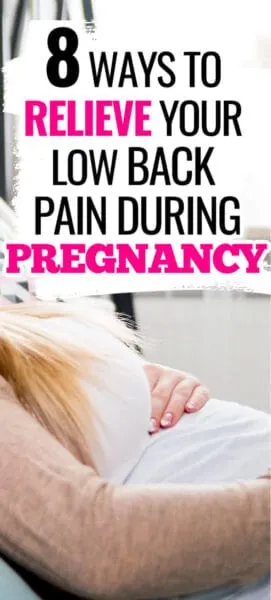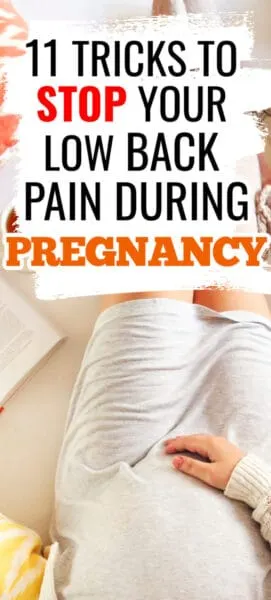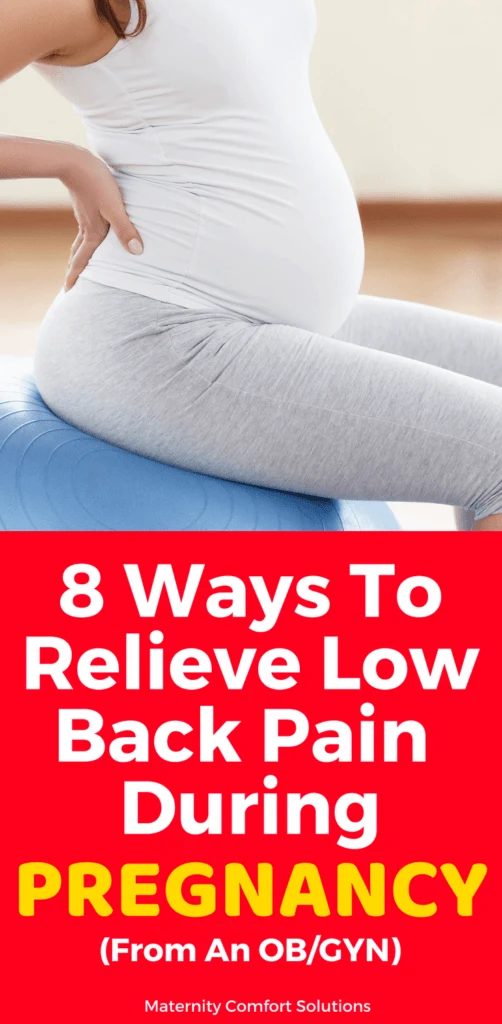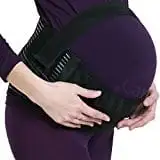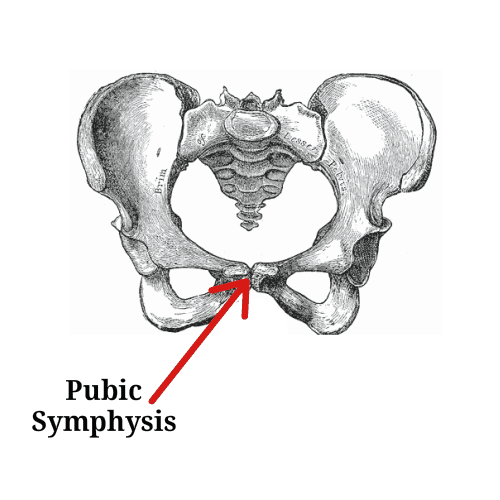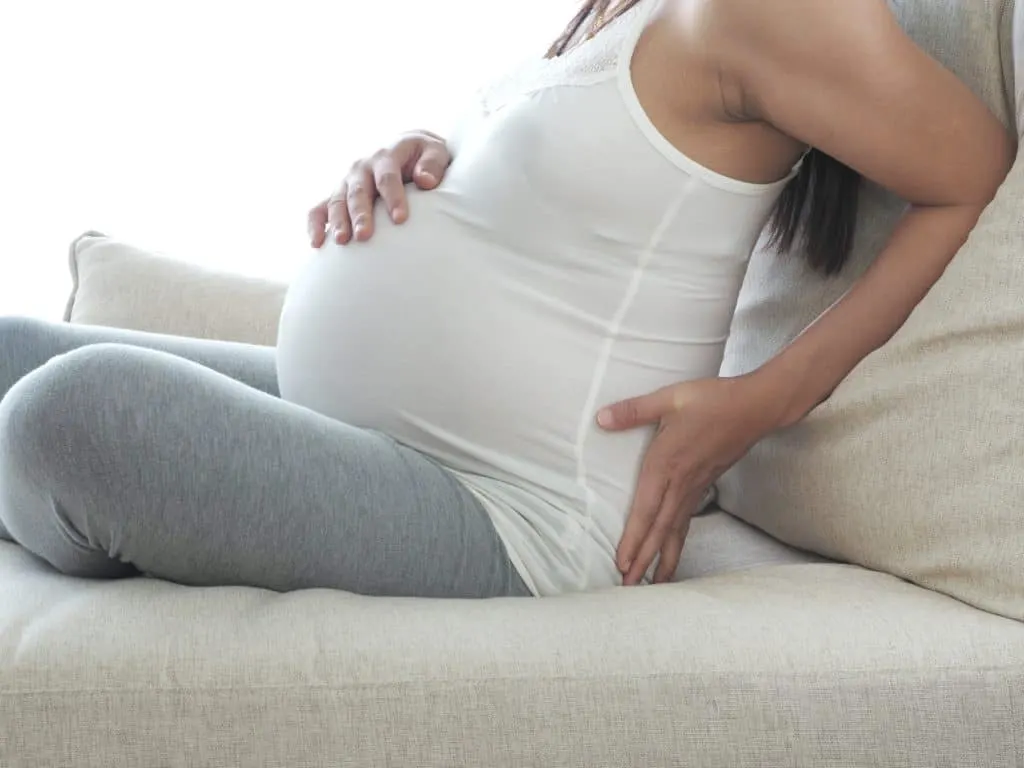
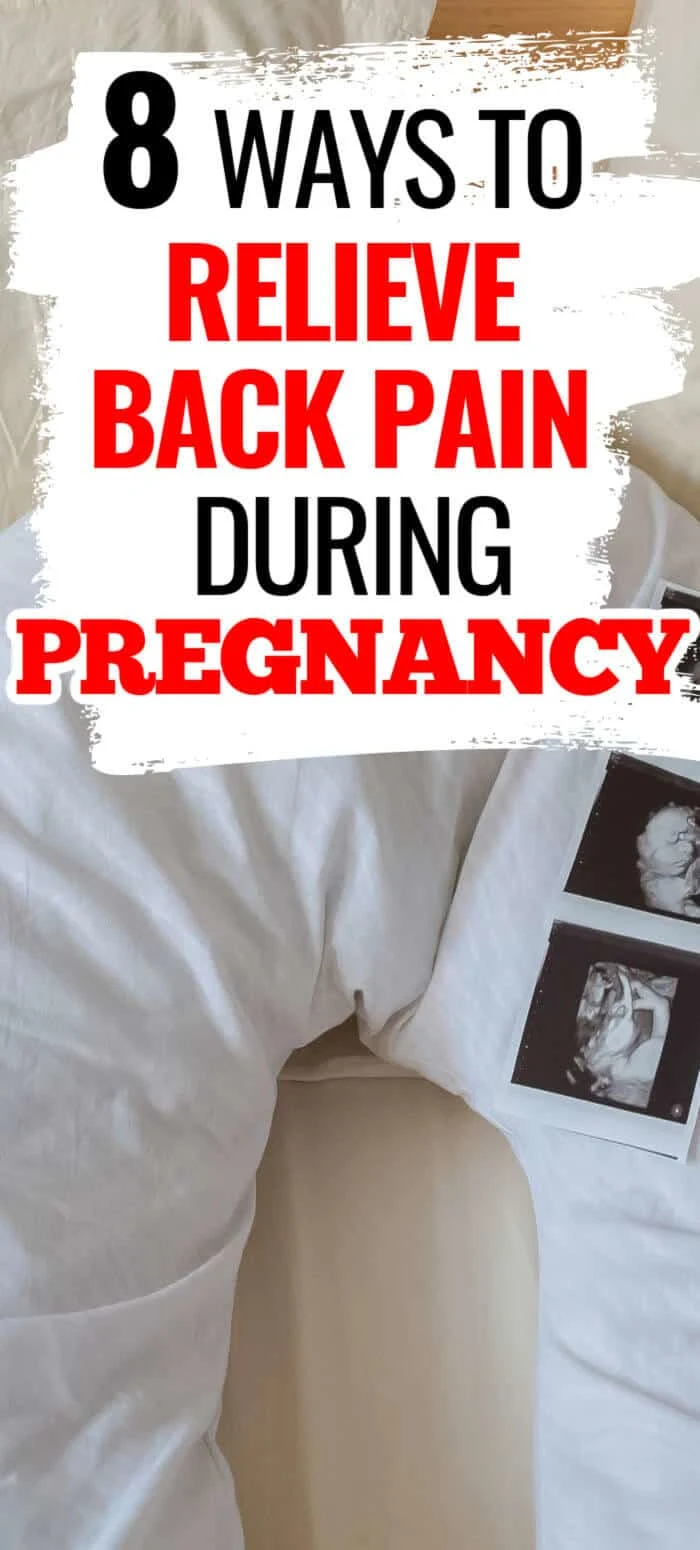
8 Ways To Relieve Low Back Pain During Pregnancy:
1. Don’t lift heavy items!
During pregnancy, you may forget your physical limitations as your ligaments and joints loosen in preparation for childbirth.
These changes make your body more prone to injury.
Always bend at your knees and lift things from a squatting position.
Divide items up to carry them more safely.
2. Maintain good posture.
During pregnancy, maintaining good posture puts a great deal of stress on your muscles and joints to keep your balance as a result of the change in your center of gravity.
Stand up straight and relax your shoulders.
Take frequent breaks from sitting. Avoid standing for too long.
3. Keep well hydrated.
Keep hydrated, especially during the summer months. Dehydration is common during pregnancy and can lead to contractions.
Keep a cool water bottle with you and drink frequently. Drinking plain water can get boring…really fast!
Try infusing your water with fresh fruits and herbs for a little variety.

4. Prevent bladder infections
Drink more fluids, void more frequently, drink cranberry juice, etc. You get the idea.
This is especially true if you tend to be prone to urinary tract infections.
The threshold for treating urinary tract infections during pregnancy is very low.
If not treated properly they can result in kidney infections.
5. Prepare a complete medical history.
Let your provider know your history of any traumatic back or pelvic injuries, herniated discs, chronic back pain, scoliosis or surgical treatments (including fusion surgery, rod placement, and herniation). This information is not only important for managing low back pain during pregnancy.
It is also very important for your anesthesiologist, should you need spinal anesthesia or an epidural. (This has nothing to do with whether you want pain control for labor or not.
This is in the event that you need anesthesia; you want your Anesthesiologist to be prepared.)
6. Practice relaxation techniques and sleep right.
Meditation, guided imagery, or deep breathing can help you relax and may help relieve your low back pain during pregnancy.
Sleeping in the right position can be helpful too! Try to sleep on your side with your knees bent.
Many pregnant women benefit from the use of a pregnancy pillow and find they get tremendous relief of their low back pain
symptoms. There are many types of pregnancy pillows and many manufacturers.
Pregnancy pillows help low back pain primarily by offering support to the head, neck, spine, hips and lower extremities.
Initially, you will very likely experience immediate improvement in sleep comfort.
However, what is most remarkable is the improvement you will notice in your low back pain over time.
The pregnancy pillow is therapeutic because it offers consistent support and alignment of your lower back.
As with any physical therapy, it will take consistent use of the pillow to experience prolonged improvement in low back pain during pregnancy.
The following standard full-body pregnancy pillows are among the most popular for sleep comfort and relief of low back and pelvic pain.
There are many other pregnancy pillow variations available to address specific needs.
Two examples are the knee pillow which is intended to help alleviate sciatic pain and the wedge pillow, which helps support the abdomen in a comfortable anatomic position.
The smaller pillows are also far more practical for those who travel and cannot carry a full-body pregnancy pillow with them.
7. Exercise Daily
Make sure you are cleared to do so by your prenatal care provider. Exercises like swimming and stretching can help your back accommodate the weight gain during pregnancy.
Walking is another great exercise during pregnancy and may help relieve your pain.
8. Use a maternity support belt for pelvic support and comfort.
These belts (also referred to as belly bands) can be extremely effective for many of the conditions noted above.
Most women, who have used a support belt, wonder how they ever did without one. support that baby bump and give your back a break!
You can get one here.
Possible causes of low back pain during pregnancy:
- Uterine Contractions*
- Weight Gain
- Posture
- Kidney Infection
- Kidney Stone
- Sciatic Pain
- Prior Back/Pelvic Trauma
- Fetal Position
- Prior Delivery
- Multiple Gestation (Twins, Triplets)
- Diastasis Recti
- Symphysis Pubis Dysfunction
- Symphyseal Separation
- Round Ligament Pain
- Scoliosis
[wps_alert type=”warning”][wps_icon icon=”check” background=”#31b522″ color=”#ffffff” size=”20″ padding=”6″ radius=”0″]It is very important to recognize and not overlook the possibility of low back pain during pregnancy resulting from uterine contractions.
Always have low back pain during pregnancy evaluated by your healthcare provider to be certain you are properly diagnosed. [/wps_alert]
1. Uterine Contractions
If low back pain occurs during your second or third trimester, particularly at regular intervals, uterine contractions resulting from premature labor must be ruled out. If you are having regular contractions, only by evaluating for cervical change can labor be ruled out
As the summer approaches, dehydration during pregnancy is common and often causes uterine contractions. Keep yourself well-hydrated during the summer months.
Carry a water bottle with you and try to drink 8 to 10 glasses of water every day. Also remember to maintain an adequate intake of electrolyte-balanced fluids (Gatorade, Pedialyte, etc.).
If you are looking for a water bottle you can keep with you, try the very popular Yetti Rambler!
YETI Rambler 36oz Vacuum Insulated Stainless Steel Bottle with Cap
2. Weight Gain
Granted this cause for low back pain during pregnancy is rather general, it is mentioned to account for the times when there are no other explanations for musculoskeletal discomfort during pregnancy.
Considering the fact that an expectant mother gains an average of 28 lbs in a relatively short period of time, one can see how this can cause back strain and stress the joints in the pelvis and hips.
3. Posture
Though this could be listed underweight gain, it is best to see this as a slightly different cause of low back pain when you are pregnant because of the way pregnancy weight is distributed.
During pregnancy, there is a tremendous amount of stress on your musculoskeletal system in the lower back. With this added pressure on your lower back, maintaining an upright posture is challenging.
Carrying so much weight in your front causes a major shift in your center of gravity.
Fortunately, this shift occurs over an extended period of time, allowing your body to make the necessary adjustments.
This puts a tremendous demand on the core muscles to maintain an upright posture.
During the second and third trimester, this increases the pressure on the joints and nerves in the lumbar and sacral region.
Maternity Pregnancy Support Belt/Brace
Back. Abdomen, Belly Band – NEOtech Care brand – Black
4. Kidney Infections
Kidney infections (pyelonephritis) can cause severe low back pain during pregnancy.
Kidney infections are more common during pregnancy because the ureters start to get partially obstructed by the uterus around 20 weeks gestation.
This causes stasis of urine in the upper urinary tract, which can predispose to kidney infections.
What is most concerning about kidney infections in the second and third trimester, is that they can cause premature labor.
5. Kidney Stones
What is most important when it comes to diagnosing kidney stones during pregnancy is one’s past medical history.
There are a number of types of kidney stones.
If you have had a kidney stone, informing your health care provider of the type of stone you had can expedite your diagnosis and treatment.
6. Sciatic Pain
Inflammation or entrapment of the sciatic nerve can lead to sciatic pain. This pain can radiate down the outside of your leg to the feet.
Sciatica can be mild or quite severe, with numbness, tingling and even decreased muscle strength.
Sciatic pain is relatively common during pregnancy due to the musculoskeletal changes that occur during pregnancy.
Those who have had sciatic pain prior to pregnancy will likely know of ways to alleviate the symptoms. During pregnancy, one way to try and get relief is to use a knee pillow.
These pillows are specifically designed for pregnancy and help to keep the pelvis and hip in proper position while you sleep.
The ComfiLife Orthopedic Knee Pillow for Sciatica Relief is an extremely popular pillow for the relief of sciatic pain during pregnancy.
The memory foam wedge design helps maintain spine alignment and can help alleviate sciatic pain and low back pain.
7. Prior Back or Pelvic trauma
Many times I have seen pregnancy stir up a prior back or pelvic injury. This is due to the anatomic and physiologic changes that occur during pregnancy to prepare the pelvis for childbirth.
When there is a history of pelvic injuries, diagnostic studies may have to be performed to be sure there are no contraindications to having a vaginal delivery.
Pelvic injuries of this sort often relate to a history of motor vehicle accidents.
8. Fetal Position Near Term
During the third trimester, the fetal head “drops down” and engages in the pelvis.
This causes increased pelvic pressure and is more common with first pregnancies.
Back discomfort may be worse if the fetus is in the posterior position (face up).
9. Prior Deliveries
Women who have had one or more deliveries may experience more sciatica or low back pain.
This is because the pelvic girdle can become looser and more unstable after delivering their first child.
The AZMED Maternity Belt can be extremely helpful for women experiencing discomfort as a result of an unstable pelvis.
Maternity belts help redistribute pregnancy weight to alleviate low back pain and sciatic pain.
There are many maternity support belts available from a number of manufacturers.
If you decide to try a maternity support belt, make sure it is designed to specifically manage your particular concern. Talk with your prenatal care provider to determine what support belt is best for you.
[content-egg module=Amazon template=item next=1 hide=price]
10. Multiple Gestation (Twins, Triplets)
It goes without saying that the additional weight associated with multiple gestations can cause significant back strain.
11. Diastasis Recti
Diastasis recti occur when there is a separation of the rectus muscles in the midline abdominal wall.
12. Symphysis Pubis Dysfunction
Symphysis Pubis Dysfunction occurs when there is a loosening or excessive movement of the pelvic joint known as the pubic symphysis.
This can result in pelvic girdle pain and instability.
Courtesy Wikimedia Commons
13. Symphyseal Separation
If the pubic symphysis separates (at delivery) the condition is referred to as Symphyseal Separation. This can be quite painful and significantly limit postpartum activity during the healing process.
Initially, a walker may be necessary along with home help from family, friends or a home health care provider. For those who experience a symphyseal separation, it is important to have an understanding support network in place.
14. Round Ligament Pain
This lower abdominal, pulling pain, unlike the symptoms listed above, is not located in the lower back.
However, because it is so common, it has been included in this discussion.
The pain is on the sides (groin region) and extends upward.
It occurs between 12 and 20 weeks, as this is the time during pregnancy when the round ligament is stretching to accommodate uterine enlargement.
After 20 weeks, this ligament no longer stretches and the pain subsides.
What is most characteristic about round ligament pain is that it is positional. It is most bothersome with movement: sitting to standing, prolonged walking or straining.
I hope this article has been informative about some (not all) causes of pelvic and low back pain during pregnancy. If you have any questions or concerns, talk with your personal healthcare provider who is familiar with your medical history and physical exam.
Other pregnancy articles you might find helpful:

